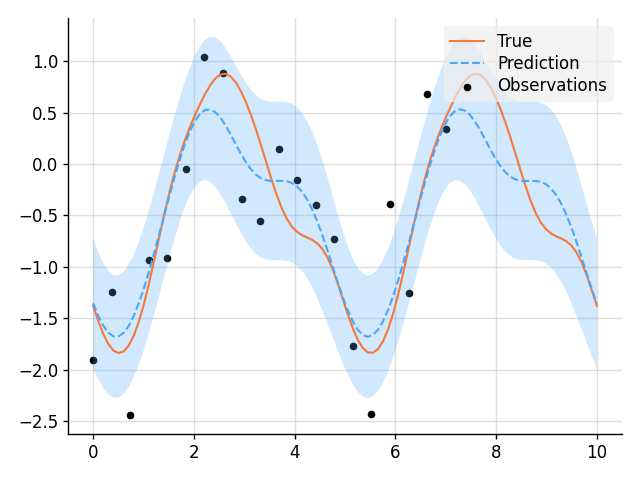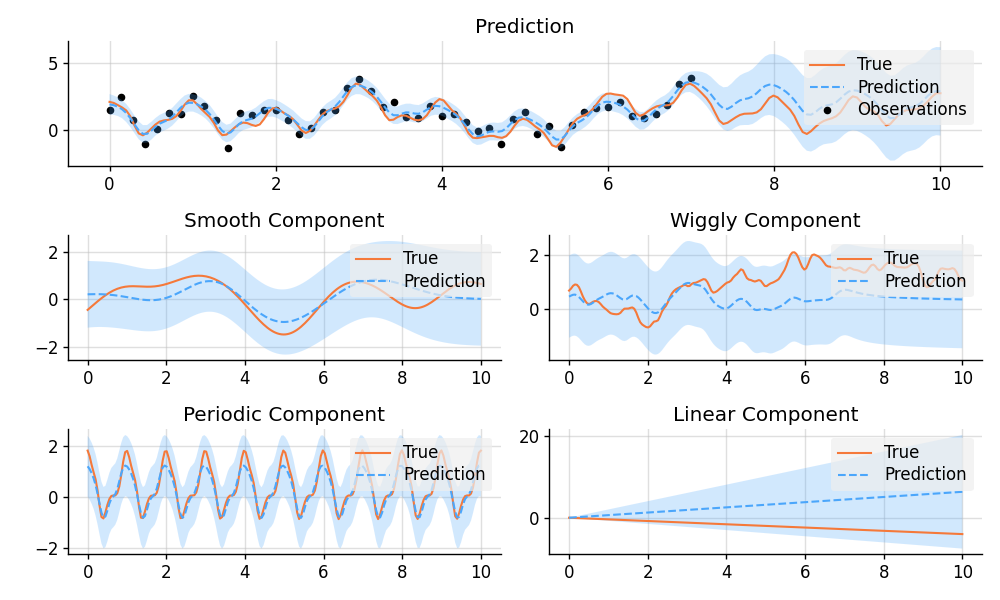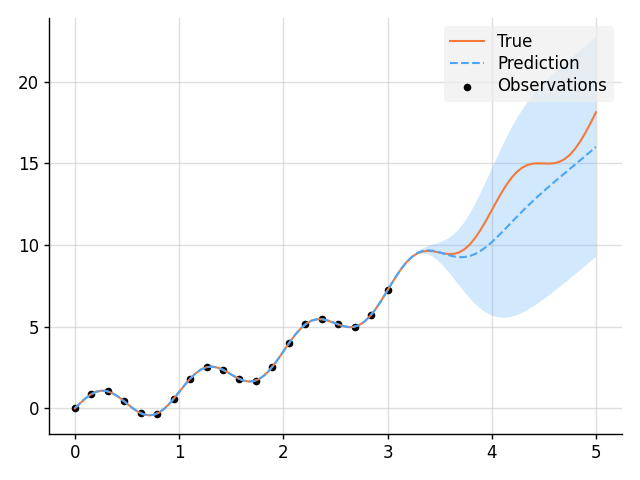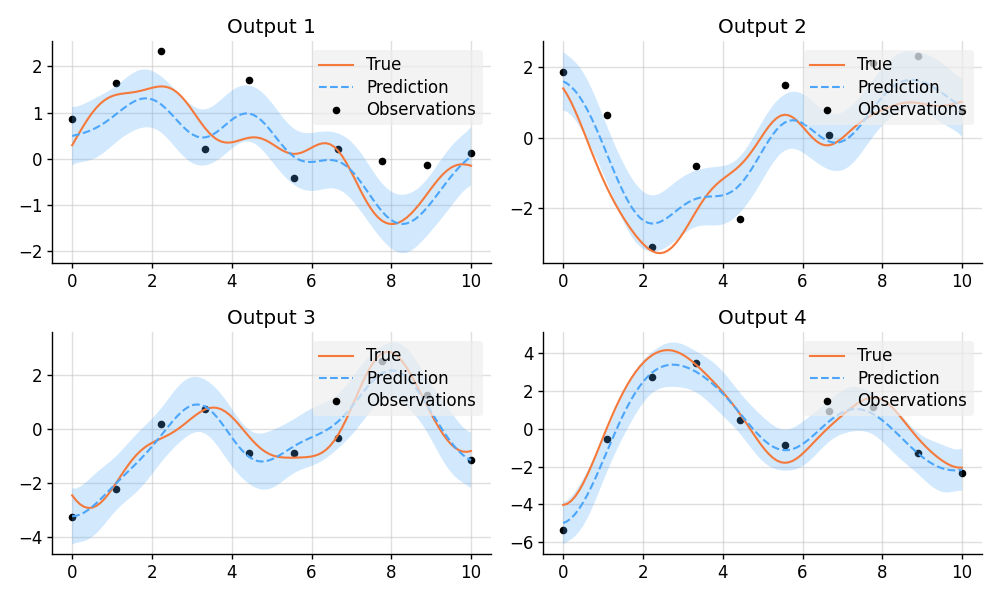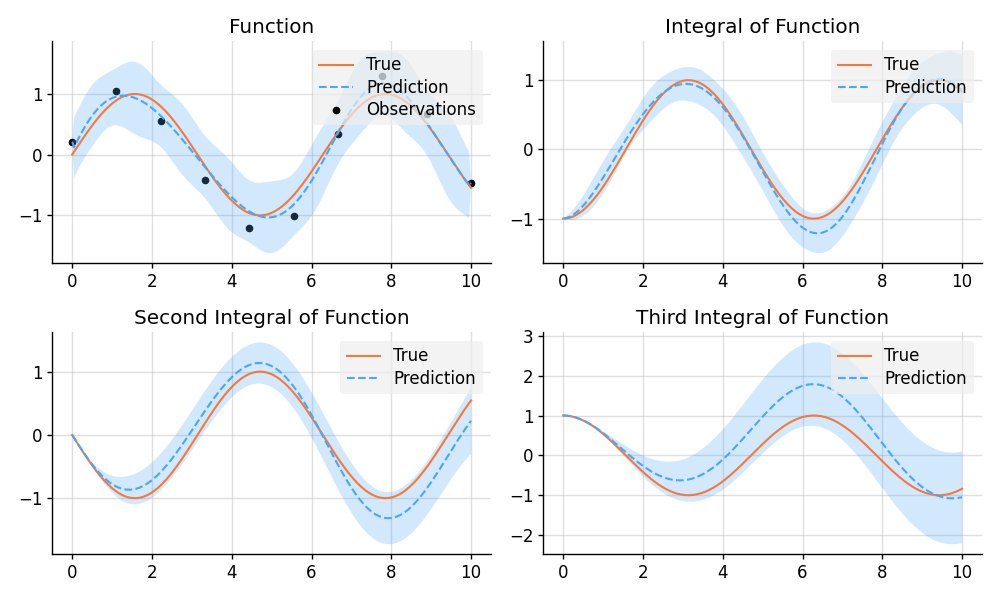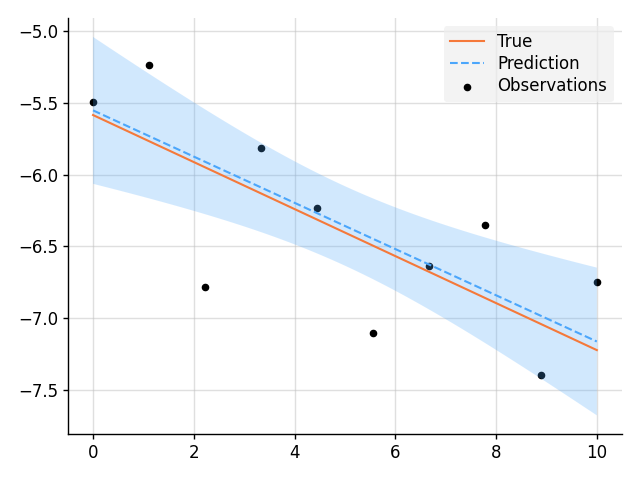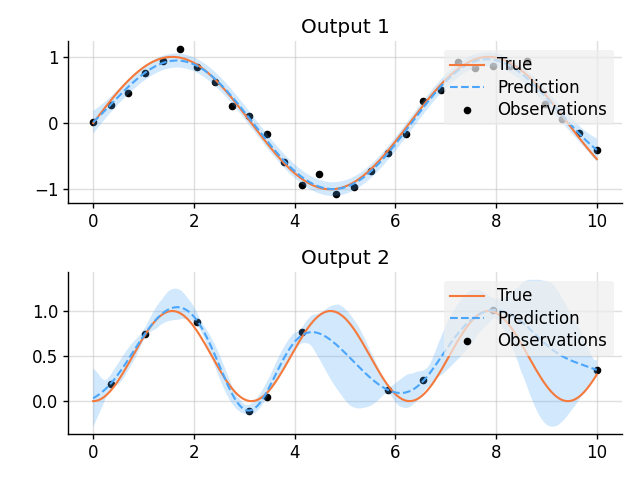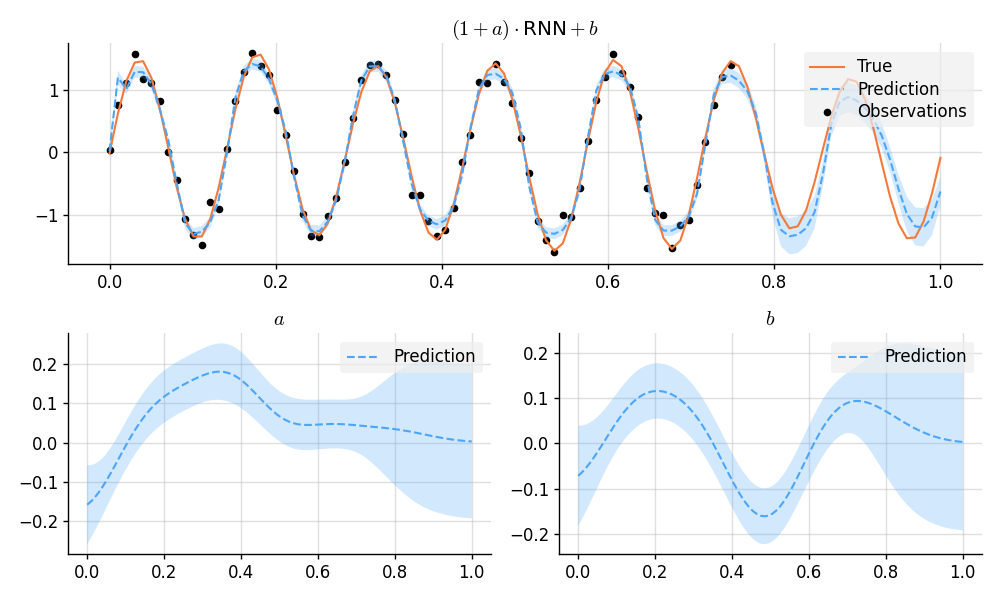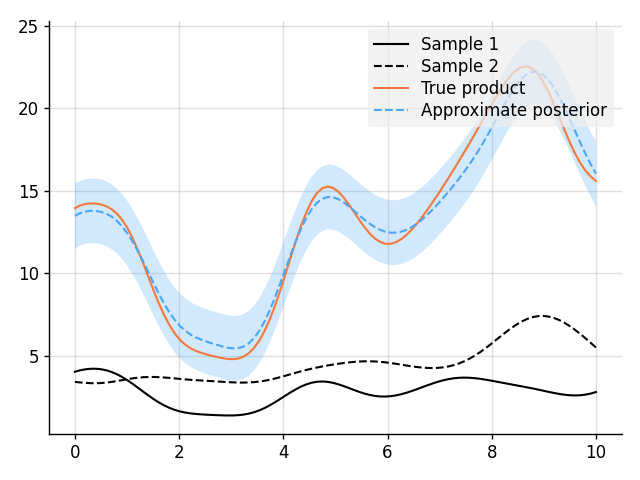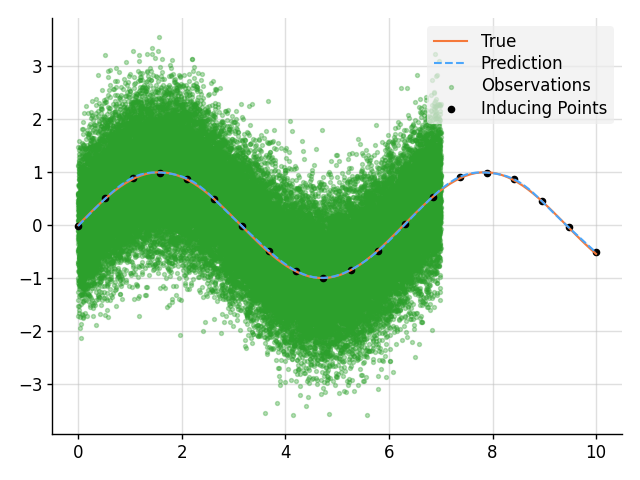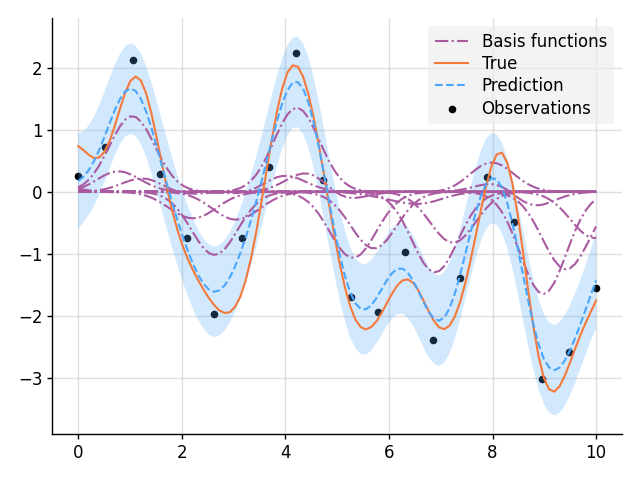Implementation of Gaussian processes in Python
Project description
Stheno
Stheno is an implementation of Gaussian process modelling in Python. See also Stheno.jl.
Note: Stheno requires Python 3.5+ and TensorFlow 2 if TensorFlow is used.
- Nonlinear Regression in 20 Seconds
- Installation
- Manual
- Examples
- Simple Regression
- Decomposition of Prediction
- Learn a Function, Incorporating Prior Knowledge About Its Form
- Multi-Output Regression
- Approximate Integration
- Bayesian Linear Regression
- GPAR
- A GP-RNN Model
- Approximate Multiplication Between GPs
- Sparse Regression
- Smoothing with Nonparametric Basis Functions
Nonlinear Regression in 20 Seconds
>>> import numpy as np
>>> from stheno import GP, EQ
>>> x = np.linspace(0, 2, 10) # Points to predict at
>>> y = x ** 2 # Observations
>>> (GP(EQ()) | (x, y))(3).mean # Go GP!
array([[8.48258669]])
Moar?! Then read on!
Installation
Before installing the package, please ensure that gcc and gfortran are
available.
On OS X, these are both installed with brew install gcc;
users of Anaconda may want to instead consider conda install gcc.
On Linux, gcc is most likely already available, and gfortran can be
installed with apt-get install gfortran.
Then simply
pip install stheno
Manual
Note: here is a nicely rendered and more readable version of the docs.
Kernel and Mean Design
Inputs to kernels, means, and GPs, henceforth referred to simply as inputs, must be of one of the following three forms:
-
If the input
xis a rank 0 tensor, i.e. a scalar, thenxrefers to a single input location. For example,0simply refers to the sole input location0. -
If the input
xis a rank 1 tensor, then every element ofxis interpreted as a separate input location. For example,np.linspace(0, 1, 10)generates 10 different input locations ranging from0to1. -
If the input
xis a rank 2 tensor, then every row ofxis interpreted as a separate input location. In this case inputs are multi-dimensional, and the columns correspond to the various input dimensions.
If k is a kernel, say k = EQ(), then k(x, y) constructs the kernel
matrix for all pairs of points between x and y. k(x) is shorthand for
k(x, x). Furthermore, k.elwise(x, y) constructs the kernel vector pairing
the points in x and y element wise, which will be a rank 2 column vector.
Example:
>>> EQ()(np.linspace(0, 1, 3))
array([[1. , 0.8824969 , 0.60653066],
[0.8824969 , 1. , 0.8824969 ],
[0.60653066, 0.8824969 , 1. ]])
>>> EQ().elwise(np.linspace(0, 1, 3), 0)
array([[1. ],
[0.8824969 ],
[0.60653066]])
Finally, mean functions output a rank 2 column vector.
Available Kernels
Constants function as constant kernels. Besides that, the following kernels are available:
-
EQ(), the exponentiated quadratic:$$ k(x, y) = \exp\left( -\frac{1}{2}|x - y|^2 \right); $$
-
RQ(alpha), the rational quadratic:$$ k(x, y) = \left( 1 + \frac{|x - y|^2}{2 \alpha} \right)^{-\alpha}; $$
-
Exp()orMatern12(), the exponential kernel:$$ k(x, y) = \exp\left( -|x - y| \right); $$
-
Matern32(), the Matern–3/2 kernel:$$ k(x, y) = \left( 1 + \sqrt{3}|x - y| \right)\exp\left(-\sqrt{3}|x - y|\right); $$
-
Matern52(), the Matern–5/2 kernel:$$ k(x, y) = \left( 1 + \sqrt{5}|x - y| + \frac{5}{3} |x - y|^2 \right)\exp\left(-\sqrt{3}|x - y|\right); $$
-
Delta(), the Kronecker delta kernel:$$ k(x, y) = \begin{cases} 1 & \text{if } x = y, \ 0 & \text{otherwise}; \end{cases} $$
-
DecayingKernel(alpha, beta):$$ k(x, y) = \frac{|\beta|^\alpha}{|x + y + \beta|^\alpha}; $$
-
TensorProductKernel(f):$$ k(x, y) = f(x)f(y). $$
Adding or multiplying a
FunctionTypefto or with a kernel will automatically translateftoTensorProductKernel(f). For example,f * kwill translate toTensorProductKernel(f) * k, andf + kwill translate toTensorProductKernel(f) + k.
Available Means
Constants function as constant means. Besides that, the following means are available:
-
TensorProductMean(f):$$ m(x) = f(x). $$
Adding or multiplying a
FunctionTypefto or with a mean will automatically translateftoTensorProductMean(f). For example,f * mwill translate toTensorProductMean(f) * m, andf + mwill translate toTensorProductMean(f) + m.
Compositional Design
-
Add and subtract kernels and means.
Example:
>>> EQ() + Exp() EQ() + Exp() >>> EQ() + EQ() 2 * EQ() >>> EQ() + 1 EQ() + 1 >>> EQ() + 0 EQ() >>> EQ() - Exp() EQ() - Exp() >>> EQ() - EQ() 0
-
Multiply kernels and means.
Example:
>>> EQ() * Exp() EQ() * Exp() >>> 2 * EQ() 2 * EQ() >>> 0 * EQ() 0
-
Shift kernels and means:
Definition:
k.shift(c)(x, y) == k(x - c, y - c) k.shift(c1, c2)(x, y) == k(x - c1, y - c2)
Example:
>>> Linear().shift(1) Linear() shift 1 >>> EQ().shift(1, 2) EQ() shift (1, 2)
-
Stretch kernels and means.
Definition:
k.stretch(c)(x, y) == k(x / c, y / c) k.stretch(c1, c2)(x, y) == k(x / c1, y / c2)
Example:
>>> EQ().stretch(2) EQ() > 2 >>> EQ().stretch(2, 3) EQ() > (2, 3)
The
>operator is implemented to provide a shorthand for stretching:>>> EQ() > 2 EQ() > 2
-
Select particular input dimensions of kernels and means.
Definition:
k.select([0])(x, y) == k(x[:, 0], y[:, 0]) k.select([0, 1])(x, y) == k(x[:, [0, 1]], y[:, [0, 1]]) k.select([0], [1])(x, y) == k(x[:, 0], y[:, 1]) k.select(None, [1])(x, y) == k(x, y[:, 1])
Example:
>>> EQ().select([0]) EQ() : [0] >>> EQ().select([0, 1]) EQ() : [0, 1] >>> EQ().select([0], [1]) EQ() : ([0], [1]) >>> EQ().select(None, [1]) EQ() : (None, [1])
-
Transform the inputs of kernels and means.
Definition:
k.transform(f)(x, y) == k(f(x), f(y)) k.transform(f1, f2)(x, y) == k(f1(x), f2(y)) k.transform(None, f)(x, y) == k(x, f(y))
Example:
>>> EQ().transform(f) EQ() transform f >>> EQ().transform(f1, f2) EQ() transform (f1, f2) >>> EQ().transform(None, f) EQ() transform (None, f)
-
Numerically, but efficiently, take derivatives of kernels and means. This currently only works in TensorFlow.
Definition:
k.diff(0)(x, y) == d/d(x[:, 0]) d/d(y[:, 0]) k(x, y) k.diff(0, 1)(x, y) == d/d(x[:, 0]) d/d(y[:, 1]) k(x, y) k.diff(None, 1)(x, y) == d/d(y[:, 1]) k(x, y)
Example:
>>> EQ().diff(0) d(0) EQ() >>> EQ().diff(0, 1) d(0, 1) EQ() >>> EQ().diff(None, 1) d(None, 1) EQ()
-
Make kernels periodic, but not means.
Definition:
k.periodic(2 pi / w)(x, y) == k((sin(w * x), cos(w * x)), (sin(w * y), cos(w * y)))
Example:
>>> EQ().periodic(1) EQ() per 1
-
Reverse the arguments of kernels, but not means.
Definition:
reversed(k)(x, y) == k(y, x)
Example:
>>> reversed(Linear()) Reversed(Linear())
-
Extract terms and factors from sums and products respectively of kernels and means.
Example:
>>> (EQ() + RQ(0.1) + Linear()).term(1) RQ(0.1) >>> (2 * EQ() * Linear).factor(0) 2
Kernels and means "wrapping" others can be "unwrapped" by indexing
k[0]orm[0].Example:
>>> reversed(Linear()) Reversed(Linear()) >>> reversed(Linear())[0] Linear() >>> EQ().periodic(1) EQ() per 1 >>> EQ().periodic(1)[0] EQ()
Displaying Kernels and Means
Kernels and means have a display method.
The display method accepts a callable formatter that will be applied before any value is printed.
This comes in handy when pretty printing kernels, or when kernels contain TensorFlow objects.
Example:
>>> print((2.12345 * EQ()).display(lambda x: '{:.2f}'.format(x)))
2.12 * EQ(), 0
>>> tf.constant(1) * EQ()
Tensor("Const_1:0", shape=(), dtype=int32) * EQ()
>>> print((tf.constant(2) * EQ()).display(tf.Session().run))
2 * EQ()
Properties of Kernels
The stationarity of a kernel k can always be determined by querying
k.stationary. In many cases, the variance k.var, length scale
k.length_scale, and period k.period can also be determined.
Example of querying the stationarity:
>>> EQ().stationary
True
>>> (EQ() + Linear()).stationary
False
Example of querying the variance:
>>> EQ().var
1
>>> (2 * EQ()).var
2
Example of querying the length scale:
>>> EQ().length_scale
1
>>> (EQ() + EQ().stretch(2)).length_scale
1.5
Example of querying the period:
>>> EQ().periodic(1).period
1
>>> EQ().periodic(1).stretch(2).period
2
Model Design
The basic building block of a model is a GP(kernel, mean=0, graph=model),
which necessarily takes in a kernel, and optionally a mean and a graph.
GPs can be combined into new GPs, and the graph is the thing that keeps
track of all of these objects.
If the graph is left unspecified, new GPs are appended to a provided default
graph model, which is exported by Stheno:
from stheno import model
Here's an example model:
>>> f1 = GP(EQ(), lambda x: x ** 2)
>>> f1
GP(EQ(), <lambda>)
>>> f2 = GP(Linear())
>>> f_sum = f1 + f2
>>> f_sum
GP(EQ() + Linear(), <lambda>)
Compositional Design
-
Add and subtract GPs and other objects.
Example:
>>> GP(EQ()) + GP(Exp()) GP(EQ() + Exp(), 0) >>> GP(EQ()) + GP(EQ()) GP(2 * EQ(), 0) >>> GP(EQ()) + 1 GP(EQ(), 1) >>> GP(EQ()) + 0 GP(EQ(), 0) >>> GP(EQ()) + (lambda x: x ** 2) GP(EQ(), <lambda>) >>> GP(EQ(), 2) - GP(EQ(), 1) GP(2 * EQ(), 1)
-
Multiply GPs by other objects.
Example:
>>> 2 * GP(EQ()) GP(2 * EQ(), 0) >>> 0 * GP(EQ()) GP(0, 0) >>> (lambda x: x) * GP(EQ()) GP(<lambda> * EQ(), 0)
-
Shift GPs.
Example:
>>> GP(EQ()).shift(1) GP(EQ() shift 1, 0)
-
Stretch GPs.
Example:
>>> GP(EQ()).stretch(2) GP(EQ() > 2, 0)
The
>operator is implemented to provide a shorthand for stretching:>>> GP(EQ()) > 2 GP(EQ() > 2, 0)
-
Select particular input dimensions.
Example:
>>> GP(EQ()).select(1, 3) GP(EQ() : [1, 3], 0)
Indexing is implemented to provide a a shorthand for selecting input dimensions:
>>> GP(EQ())[1, 3] GP(EQ() : [1, 3], 0)
-
Transform the input.
Example:
>>> GP(EQ()).transform(f) GP(EQ() transform f, 0)
-
Numerically take the derivative of a GP. The argument specifies which dimension to take the derivative with respect to.
Example:
>>> GP(EQ()).diff(1) GP(d(1) EQ(), 0)
-
Construct a finite difference estimate of the derivative of a GP. See
stheno.graph.Graph.diff_approxfor a description of the arguments.Example:
>>> GP(EQ()).diff_approx(deriv=1, order=2) GP(50000000.0 * (0.5 * EQ() + 0.5 * ((-0.5 * (EQ() shift (0.0001414213562373095, 0))) shift (0, -0.0001414213562373095)) + 0.5 * ((-0.5 * (EQ() shift (0, 0.0001414213562373095))) shift (-0.0001414213562373095, 0))), 0)
-
Construct the Cartesian product of a collection of GPs.
Example:
>>> model = Graph() >>> f1, f2 = GP(EQ(), graph=model), GP(EQ(), graph=model) >>> model.cross(f1, f2) GP(MultiOutputKernel(EQ(), EQ()), MultiOutputMean(0, 0))
Displaying GPs
Like kernels and means, GPs have a display method that accepts a formatter.
Example:
>>> print(GP(2.12345 * EQ()).display(lambda x: '{:.2f}'.format(x)))
GP(2.12 * EQ(), 0)
Properties of GPs
Properties of kernels can be queried on GPs directly.
Example:
>>> GP(EQ()).stationary
True
>>> GP(RQ(1e-1)).length_scale
1
Naming GPs
It is possible to give a name to GPs. Names must be strings. A graph then behaves like a two-way dictionary between GPs and their names.
Example:
>>> p = GP(EQ(), name='prior')
>>> p.name
'prior'
>>> p.name = 'alternative_prior'
>>> model['alternative_prior']
GP(EQ(), 0)
>>> model[p]
'alternative_prior'
Finite-Dimensional Distributions, Inference, and Sampling
Simply call a GP to construct its finite-dimensional distribution:
>>> type(f(x))
stheno.random.Normal
>>> f(x).mean
array([[0.],
[0.],
[0.]])
>>> f(x).var
array([[1. , 0.8824969 , 0.60653066],
[0.8824969 , 1. , 0.8824969 ],
[0.60653066, 0.8824969 , 1. ]])
>>> f(x).sample(1)
array([[-0.47676132],
[-0.51696144],
[-0.77643117]])
>>> y1 = f(x).sample(1)
>>> f(x).logpdf(y1)
-1.348196150807441
>>> y2 = f(x).sample(2)
>>> f(x).logpdf(y2)
array([-1.00581476, -1.67625465])
If you wish to compute the evidence of multiple observations,
then Graph.logpdf can be used.
Definition:
Graph.logpdf(f(x), y)
Graph.logpdf((f1(x1), y1), (f2(x2), y2), ...)
Furthermore, use f(x).marginals() to efficiently compute the means and
the marginal lower and upper 95% central credible region bounds:
>>> f(x).marginals()
(array([0., 0., 0.]), array([-2., -2., -2.]), array([2., 2., 2.]))
To condition on observations, use Graph.condition or GP.condition.
Syntax is much like the math:
compare f1_posterior = f1 | (f2(x), y) with $f_1 ,|, f_2(x) = y$.
Definition, where f* and g* are GPs:
f_posterior = f | (x, y)
f_posterior = f | (g1(x), y)
f_posterior = f | ((g1(x1), y1), (g2(x2), y2), ...)
f1_posterior, f2_posterior, ... = (f1, f2, ...) | Obs(g(x), y)
f1_posterior, f2_posterior, ... = (f1, f2, ...) | Obs((g1(x1), y1), (g2(x2), y2), ...)
Finally, Graph.sample can be used to get samples from multiple processes
jointly:
>>> model.sample(f(x), (2 * f)(x))
[array([[-0.35226314],
[-0.15521219],
[ 0.0752406 ]]),
array([[-0.70452827],
[-0.31042226],
[ 0.15048168]])]
Inducing Points
Stheno supports sparse approximations of posterior distributions. To construct
a sparse approximation, use SparseObs instead of Obs.
Definition:
obs = SparseObs(u(z), # Locations of inducing points.
e, # Independent, additive noise process.
f(x), # Locations of observations _without_ the noise
# process added.
y) # Observations.
obs = SparseObs(u(z), e, f(x), y)
obs = SparseObs(u(z), (e1, f1(x1), y1), (e2, f2(x2), y2), ...)
obs = SparseObs((u1(z1), u2(z2), ...), e, f(x), y)
obs = SparseObs(u(z), (e1, f1(x1), y1), (e2, f2(x2), y2), ...)
obs = SparseObs((u1(z1), u2(z2), ...), (e1, f1(x1), y1), (e2, f2(x2), y2), ...)
SparseObs will also compute the value of the ELBO in obs.elbo, which can be
optimised to select hyperparameters and locations of the inducing points.
AutoGrad, TensorFlow, or PyTorch?
Your choice!
from stheno.autograd import GP, EQ
from stheno.tensorflow import GP, EQ
from stheno.torch import GP, EQ
Undiscussed Features
-
stheno.mokernelandstheno.momeanoffer multi-output kernels and means.Example:
>>> model = Graph() >>> f1, f2 = GP(EQ(), graph=model), GP(EQ(), graph=model) >>> f = model.cross(f1, f2) >>> f GP(MultiOutputKernel(EQ(), EQ()), MultiOutputMean(0, 0)) >>> f(0).sample() array([[ 1.1725799 ], [-1.15642448]])
-
stheno.eisoffers kernels on an extended input space that allows one to design kernels in an alternative, flexible way.Example:
>>> p = GP(NoisyKernel(EQ(), Delta())) >>> prediction = p.condition(Observed(x), y)(Latent(x)).marginals()
-
stheno.normaloffers an efficient implementationNormalof the normal distribution, and a convenience constructorNormal1Dfor 1-dimensional normal distributions. -
stheno.matrixoffers structured representations of matrices and efficient operations thereon. -
Approximate multiplication between GPs is implemented. This is an experimental feature.
Example:
>>> GP(EQ(), 1) * GP(EQ(), 1) GP(<lambda> * EQ() + <lambda> * EQ() + EQ() * EQ(), <lambda> + <lambda> + -1 * 1)
Examples
The examples make use of Varz and some utility from WBML.
Simple Regression
import matplotlib.pyplot as plt
import numpy as np
import wbml.plot
from stheno import GP, EQ, Delta, model
# Define points to predict at.
x = np.linspace(0, 10, 100)
x_obs = np.linspace(0, 7, 20)
# Construct a prior.
f = GP(EQ().periodic(5.)) # Latent function.
e = GP(Delta()) # Noise.
y = f + .5 * e
# Sample a true, underlying function and observations.
f_true, y_obs = model.sample(f(x), y(x_obs))
# Now condition on the observations to make predictions.
mean, lower, upper = (f | (y(x_obs), y_obs))(x).marginals()
# Plot result.
plt.plot(x, f_true, label='True', c='tab:blue')
plt.scatter(x_obs, y_obs, label='Observations', c='tab:red')
plt.plot(x, mean, label='Prediction', c='tab:green')
plt.plot(x, lower, ls='--', c='tab:green')
plt.plot(x, upper, ls='--', c='tab:green')
wbml.plot.tweak()
plt.savefig('readme_example1_simple_regression.png')
plt.show()
Decomposition of Prediction
import matplotlib.pyplot as plt
import numpy as np
import wbml.plot
from stheno import GP, model, EQ, RQ, Linear, Delta, Exp, Obs, B
B.epsilon = 1e-10
# Define points to predict at.
x = np.linspace(0, 10, 200)
x_obs = np.linspace(0, 7, 50)
# Construct a latent function consisting of four different components.
f_smooth = GP(EQ())
f_wiggly = GP(RQ(1e-1).stretch(.5))
f_periodic = GP(EQ().periodic(1.))
f_linear = GP(Linear())
f = f_smooth + f_wiggly + f_periodic + .2 * f_linear
# Let the observation noise consist of a bit of exponential noise.
e_indep = GP(Delta())
e_exp = GP(Exp())
e = e_indep + .3 * e_exp
# Sum the latent function and observation noise to get a model for the
# observations.
y = f + .5 * e
# Sample a true, underlying function and observations.
f_true_smooth, f_true_wiggly, f_true_periodic, f_true_linear, f_true, y_obs = \
model.sample(f_smooth(x),
f_wiggly(x),
f_periodic(x),
f_linear(x),
f(x),
y(x_obs))
# Now condition on the observations and make predictions for the latent
# function and its various components.
f_smooth, f_wiggly, f_periodic, f_linear, f = \
(f_smooth, f_wiggly, f_periodic, f_linear, f) | Obs(y(x_obs), y_obs)
pred_smooth = f_smooth(x).marginals()
pred_wiggly = f_wiggly(x).marginals()
pred_periodic = f_periodic(x).marginals()
pred_linear = f_linear(x).marginals()
pred_f = f(x).marginals()
# Plot results.
def plot_prediction(x, f, pred, x_obs=None, y_obs=None):
plt.plot(x, f, label='True', c='tab:blue')
if x_obs is not None:
plt.scatter(x_obs, y_obs, label='Observations', c='tab:red')
mean, lower, upper = pred
plt.plot(x, mean, label='Prediction', c='tab:green')
plt.plot(x, lower, ls='--', c='tab:green')
plt.plot(x, upper, ls='--', c='tab:green')
wbml.plot.tweak()
plt.figure(figsize=(10, 6))
plt.subplot(3, 1, 1)
plt.title('Prediction')
plot_prediction(x, f_true, pred_f, x_obs, y_obs)
plt.subplot(3, 2, 3)
plt.title('Smooth Component')
plot_prediction(x, f_true_smooth, pred_smooth)
plt.subplot(3, 2, 4)
plt.title('Wiggly Component')
plot_prediction(x, f_true_wiggly, pred_wiggly)
plt.subplot(3, 2, 5)
plt.title('Periodic Component')
plot_prediction(x, f_true_periodic, pred_periodic)
plt.subplot(3, 2, 6)
plt.title('Linear Component')
plot_prediction(x, f_true_linear, pred_linear)
plt.savefig('readme_example2_decomposition.png')
plt.show()
Learn a Function, Incorporating Prior Knowledge About Its Form
import matplotlib.pyplot as plt
import tensorflow as tf
import wbml.out
import wbml.plot
from varz.tensorflow import Vars, minimise_l_bfgs_b
from stheno.tensorflow import B, Graph, GP, EQ, Delta
# Define points to predict at.
x = B.linspace(tf.float64, 0, 5, 100)
x_obs = B.linspace(tf.float64, 0, 3, 20)
def model(vs):
g = Graph()
# Random fluctuation:
u = GP(vs.pos(.5, name='u/var') *
EQ().stretch(vs.pos(0.5, name='u/scale')), graph=g)
# Noise:
e = GP(vs.pos(0.5, name='e/var') * Delta(), graph=g)
# Construct model:
alpha = vs.pos(1.2, name='alpha')
f = u + (lambda x: x ** alpha)
y = f + e
return f, y
# Sample a true, underlying function and observations.
vs = Vars(tf.float64)
f_true = x ** 1.8 + B.sin(2 * B.pi * x)
f, y = model(vs)
y_obs = (y | (f(x), f_true))(x_obs).sample()
def objective(vs):
f, y = model(vs)
evidence = y(x_obs).logpdf(y_obs)
return -evidence
# Learn hyperparameters.
minimise_l_bfgs_b(tf.function(objective, autograph=False), vs)
f, y = model(vs)
# Print the learned parameters.
wbml.out.kv('Alpha', vs['alpha'])
wbml.out.kv('Prior', y.display(wbml.out.format))
# Condition on the observations to make predictions.
mean, lower, upper = (f | (y(x_obs), y_obs))(x).marginals()
# Plot result.
plt.plot(x, B.squeeze(f_true), label='True', c='tab:blue')
plt.scatter(x_obs, B.squeeze(y_obs), label='Observations', c='tab:red')
plt.plot(x, mean, label='Prediction', c='tab:green')
plt.plot(x, lower, ls='--', c='tab:green')
plt.plot(x, upper, ls='--', c='tab:green')
wbml.plot.tweak()
plt.savefig('readme_example3_parametric.png')
plt.show()
Multi-Output Regression
import matplotlib.pyplot as plt
import numpy as np
from plum import Dispatcher, Referentiable, Self
import wbml.plot
from stheno import GP, EQ, Delta, model, Kernel, Obs
class VGP(Referentiable):
"""A vector-valued GP.
Args:
dim (int): Dimensionality.
kernel (instance of :class:`stheno.kernel.Kernel`): Kernel.
"""
dispatch = Dispatcher(in_class=Self)
@dispatch(int, Kernel)
def __init__(self, dim, kernel):
self.ps = [GP(kernel) for _ in range(dim)]
@dispatch([GP])
def __init__(self, *ps):
self.ps = ps
@dispatch(Self)
def __add__(self, other):
return VGP(*[f + g for f, g in zip(self.ps, other.ps)])
@dispatch(np.ndarray)
def lmatmul(self, A):
m, n = A.shape
ps = [0 for _ in range(m)]
for i in range(m):
for j in range(n):
ps[i] += A[i, j] * self.ps[j]
return VGP(*ps)
def sample(self, x):
return model.sample(*(p(x) for p in self.ps))
def __or__(self, obs):
return VGP(*(p | obs for p in self.ps))
def obs(self, x, ys):
return Obs(*((p(x), y) for p, y in zip(self.ps, ys)))
def marginals(self, x):
return [p(x).marginals() for p in self.ps]
# Define points to predict at.
x = np.linspace(0, 10, 100)
x_obs = np.linspace(0, 10, 10)
# Model parameters:
m = 2
p = 4
H = np.random.randn(p, m)
# Construct latent functions
us = VGP(m, EQ())
fs = us.lmatmul(H)
# Construct noise.
e = VGP(p, 0.5 * Delta())
# Construct observation model.
ys = e + fs
# Sample a true, underlying function and observations.
fs_true = fs.sample(x)
ys_obs = (ys | fs.obs(x, fs_true)).sample(x_obs)
# Condition the model on the observations to make predictions.
preds = (fs | ys.obs(x_obs, ys_obs)).marginals(x)
# Plot results.
def plot_prediction(x, f, pred, x_obs=None, y_obs=None):
plt.plot(x, f, label='True', c='tab:blue')
if x_obs is not None:
plt.scatter(x_obs, y_obs, label='Observations', c='tab:red')
mean, lower, upper = pred
plt.plot(x, mean, label='Prediction', c='tab:green')
plt.plot(x, lower, ls='--', c='tab:green')
plt.plot(x, upper, ls='--', c='tab:green')
wbml.plot.tweak()
plt.figure(figsize=(10, 6))
for i in range(p):
plt.subplot(int(p ** .5), int(p ** .5), i + 1)
plt.title('Output {}'.format(i + 1))
plot_prediction(x, fs_true[i], preds[i], x_obs, ys_obs[i])
plt.savefig('readme_example4_multi-output.png')
plt.show()
Approximate Integration
import matplotlib.pyplot as plt
import numpy as np
import tensorflow as tf
import wbml.plot
from stheno.tensorflow import B, GP, EQ, Delta, Obs
# Define points to predict at.
x = B.linspace(tf.float64, 0, 10, 200)
x_obs = B.linspace(tf.float64, 0, 10, 10)
# Construct the model.
f = 0.7 * GP(EQ()).stretch(1.5)
e = 0.2 * GP(Delta())
# Construct derivatives.
df = f.diff()
ddf = df.diff()
dddf = ddf.diff() + e
# Fix the integration constants.
zero = tf.constant(0, dtype=tf.float64)
one = tf.constant(1, dtype=tf.float64)
f, df, ddf, dddf = (f, df, ddf, dddf) | Obs((f(zero), one),
(df(zero), zero),
(ddf(zero), -one))
# Sample observations.
y_obs = B.sin(x_obs) + 0.2 * B.randn(*x_obs.shape)
# Condition on the observations to make predictions.
f, df, ddf, dddf = (f, df, ddf, dddf) | Obs(dddf(x_obs), y_obs)
# And make predictions.
pred_iiif = f(x).marginals()
pred_iif = df(x).marginals()
pred_if = ddf(x).marginals()
pred_f = dddf(x).marginals()
# Plot result.
def plot_prediction(x, f, pred, x_obs=None, y_obs=None):
plt.plot(x, f, label='True', c='tab:blue')
if x_obs is not None:
plt.scatter(x_obs, y_obs, label='Observations', c='tab:red')
mean, lower, upper = pred
plt.plot(x, mean, label='Prediction', c='tab:green')
plt.plot(x, lower, ls='--', c='tab:green')
plt.plot(x, upper, ls='--', c='tab:green')
wbml.plot.tweak()
plt.figure(figsize=(10, 6))
plt.subplot(2, 2, 1)
plt.title('Function')
plot_prediction(x, np.sin(x), pred_f, x_obs=x_obs, y_obs=y_obs)
plt.subplot(2, 2, 2)
plt.title('Integral of Function')
plot_prediction(x, -np.cos(x), pred_if)
plt.subplot(2, 2, 3)
plt.title('Second Integral of Function')
plot_prediction(x, -np.sin(x), pred_iif)
plt.subplot(2, 2, 4)
plt.title('Third Integral of Function')
plot_prediction(x, np.cos(x), pred_iiif)
plt.savefig('readme_example5_integration.png')
plt.show()
Bayesian Linear Regression
import matplotlib.pyplot as plt
import numpy as np
import wbml.out
import wbml.plot
from stheno import GP, Delta, model, Obs
# Define points to predict at.
x = np.linspace(0, 10, 200)
x_obs = np.linspace(0, 10, 10)
# Construct the model.
slope = GP(1)
intercept = GP(5)
f = slope * (lambda x: x) + intercept
e = 0.2 * GP(Delta()) # Noise model
y = f + e # Observation model
# Sample a slope, intercept, underlying function, and observations.
true_slope, true_intercept, f_true, y_obs = \
model.sample(slope(0), intercept(0), f(x), y(x_obs))
# Condition on the observations to make predictions.
slope, intercept, f = (slope, intercept, f) | Obs(y(x_obs), y_obs)
mean, lower, upper = f(x).marginals()
wbml.out.kv('True slope', true_slope[0, 0])
wbml.out.kv('Predicted slope', slope(0).mean[0, 0])
wbml.out.kv('True intercept', true_intercept[0, 0])
wbml.out.kv('Predicted intercept', intercept(0).mean[0, 0])
# Plot result.
plt.plot(x, f_true, label='True', c='tab:blue')
plt.scatter(x_obs, y_obs, label='Observations', c='tab:red')
plt.plot(x, mean, label='Prediction', c='tab:green')
plt.plot(x, lower, ls='--', c='tab:green')
plt.plot(x, upper, ls='--', c='tab:green')
wbml.plot.tweak()
plt.savefig('readme_example6_blr.png')
plt.show()
GPAR
import matplotlib.pyplot as plt
import numpy as np
import tensorflow as tf
import wbml.plot
from varz.tensorflow import Vars, minimise_l_bfgs_b
from stheno.tensorflow import B, Graph, GP, Delta, EQ
# Define points to predict at.
x = B.linspace(tf.float64, 0, 10, 200)
x_obs1 = B.linspace(tf.float64, 0, 10, 30)
inds2 = np.random.permutation(len(x_obs1))[:10]
x_obs2 = B.take(x_obs1, inds2)
# Construction functions to predict and observations.
f1_true = B.sin(x)
f2_true = B.sin(x) ** 2
y1_obs = B.sin(x_obs1) + 0.1 * B.randn(*x_obs1.shape)
y2_obs = B.sin(x_obs2) ** 2 + 0.1 * B.randn(*x_obs2.shape)
def model(vs):
g = Graph()
# Construct model for first layer:
f1 = GP(vs.pos(1., name='f1/var') *
EQ().stretch(vs.pos(1., name='f1/scale')), graph=g)
e1 = GP(vs.pos(0.1, name='e1/var') * Delta(), graph=g)
y1 = f1 + e1
# Construct model for second layer:
f2 = GP(vs.pos(1., name='f2/var') *
EQ().stretch(vs.pos(np.array([1., .5]), name='f2/scale')), graph=g)
e2 = GP(vs.pos(0.1, name='e2/var') * Delta(), graph=g)
y2 = f2 + e2
return f1, y1, f2, y2
def objective(vs):
f1, y1, f2, y2 = model(vs)
x1 = x_obs1
x2 = B.stack(x_obs2, B.take(y1_obs, inds2), axis=1)
evidence = y1(x1).logpdf(y1_obs) + y2(x2).logpdf(y2_obs)
return -evidence
# Learn hyperparameters.
vs = Vars(tf.float64)
minimise_l_bfgs_b(objective, vs)
f1, y1, f2, y2 = model(vs)
# Condition to make predictions.
x1 = x_obs1
x2 = B.stack(x_obs2, B.take(y1_obs, inds2), axis=1)
f1 = f1 | (y1(x1), y1_obs)
f2 = f2 | (y2(x2), y2_obs)
# Predict first output.
mean1, lower1, upper1 = f1(x).marginals()
# Predict second output with Monte Carlo.
samples = [f2(B.stack(x, f1(x).sample()[:, 0], axis=1)).sample()[:, 0]
for _ in range(100)]
mean2 = np.mean(samples, axis=0)
lower2 = np.percentile(samples, 2.5, axis=0)
upper2 = np.percentile(samples, 100 - 2.5, axis=0)
# Plot result.
plt.figure()
plt.subplot(2, 1, 1)
plt.title('Output 1')
plt.plot(x, f1_true, label='True', c='tab:blue')
plt.scatter(x_obs1, y1_obs, label='Observations', c='tab:red')
plt.plot(x, mean1, label='Prediction', c='tab:green')
plt.plot(x, lower1, ls='--', c='tab:green')
plt.plot(x, upper1, ls='--', c='tab:green')
wbml.plot.tweak()
plt.subplot(2, 1, 2)
plt.title('Output 2')
plt.plot(x, f2_true, label='True', c='tab:blue')
plt.scatter(x_obs2, y2_obs, label='Observations', c='tab:red')
plt.plot(x, mean2, label='Prediction', c='tab:green')
plt.plot(x, lower2, ls='--', c='tab:green')
plt.plot(x, upper2, ls='--', c='tab:green')
wbml.plot.tweak()
plt.savefig('readme_example7_gpar.png')
plt.show()
A GP-RNN Model
import matplotlib.pyplot as plt
import numpy as np
import tensorflow as tf
import wbml.plot
from varz.tensorflow import Vars, minimise_adam
from wbml.net import rnn as rnn_constructor
from stheno.tensorflow import B, Graph, GP, Delta, EQ, Obs
# Increase regularisation because we are dealing with float32.
B.epsilon = 1e-6
# Construct points which to predict at.
x = B.linspace(tf.float32, 0, 1, 100)[:, None]
inds_obs = np.arange(0, int(0.75 * len(x))) # Train on the first 75% only.
x_obs = B.take(x, inds_obs)
# Construct function and observations.
# Draw random modulation functions.
a_true = GP(1e-2 * EQ().stretch(0.1))(x).sample()
b_true = GP(1e-2 * EQ().stretch(0.1))(x).sample()
# Construct the true, underlying function.
f_true = (1 + a_true) * B.sin(2 * np.pi * 7 * x) + b_true
# Add noise.
y_true = f_true + 0.1 * B.randn(*f_true.shape)
# Normalise and split.
f_true = (f_true - B.mean(y_true)) / B.std(y_true)
y_true = (y_true - B.mean(y_true)) / B.std(y_true)
y_obs = B.take(y_true, inds_obs)
def model(vs):
g = Graph()
# Construct an RNN.
f_rnn = rnn_constructor(output_size=1,
widths=(10,),
nonlinearity=B.tanh,
final_dense=True)
# Set the weights for the RNN.
num_weights = f_rnn.num_weights(input_size=1)
weights = Vars(tf.float32, source=vs.get(shape=(num_weights,), name='rnn'))
f_rnn.initialise(input_size=1, vs=weights)
# Construct GPs that modulate the RNN.
a = GP(1e-2 * EQ().stretch(vs.pos(0.1, name='a/scale')), graph=g)
b = GP(1e-2 * EQ().stretch(vs.pos(0.1, name='b/scale')), graph=g)
e = GP(vs.pos(1e-2, name='e/var') * Delta(), graph=g)
# GP-RNN model:
f_gp_rnn = (1 + a) * (lambda x: f_rnn(x)) + b
y_gp_rnn = f_gp_rnn + e
return f_rnn, f_gp_rnn, y_gp_rnn, a, b
def objective_rnn(vs):
f_rnn, _, _, _, _ = model(vs)
return B.mean((f_rnn(x_obs) - y_obs) ** 2)
def objective_gp_rnn(vs):
_, _, y_gp_rnn, _, _ = model(vs)
evidence = y_gp_rnn(x_obs).logpdf(y_obs)
return -evidence
# Pretrain the RNN.
vs = Vars(tf.float32)
minimise_adam(tf.function(objective_rnn, autograph=False),
vs, rate=1e-2, iters=1000, trace=True)
# Jointly train the RNN and GPs.
minimise_adam(tf.function(objective_gp_rnn, autograph=False),
vs, rate=1e-3, iters=1000, trace=True)
_, f_gp_rnn, y_gp_rnn, a, b = model(vs)
# Condition.
f_gp_rnn, a, b = (f_gp_rnn, a, b) | Obs(y_gp_rnn(x_obs), y_obs)
# Predict and plot results.
plt.figure(figsize=(10, 6))
plt.subplot(2, 1, 1)
plt.title('$(1 + a)\\cdot {}$RNN${} + b$')
plt.plot(x, f_true, label='True', c='tab:blue')
plt.scatter(x_obs, y_obs, label='Observations', c='tab:red')
mean, lower, upper = f_gp_rnn(x).marginals()
plt.plot(x, mean, label='Prediction', c='tab:green')
plt.plot(x, lower, ls='--', c='tab:green')
plt.plot(x, upper, ls='--', c='tab:green')
wbml.plot.tweak()
plt.subplot(2, 2, 3)
plt.title('$a$')
mean, lower, upper = a(x).marginals()
plt.plot(x, mean, label='Prediction', c='tab:green')
plt.plot(x, lower, ls='--', c='tab:green')
plt.plot(x, upper, ls='--', c='tab:green')
wbml.plot.tweak()
plt.subplot(2, 2, 4)
plt.title('$b$')
mean, lower, upper = b(x).marginals()
plt.plot(x, mean, label='Prediction', c='tab:green')
plt.plot(x, lower, ls='--', c='tab:green')
plt.plot(x, upper, ls='--', c='tab:green')
wbml.plot.tweak()
plt.savefig(f'readme_example8_gp-rnn.png')
plt.show()
Approximate Multiplication Between GPs
import matplotlib.pyplot as plt
import numpy as np
import wbml.plot
from stheno import GP, EQ, model, Obs
# Define points to predict at.
x = np.linspace(0, 10, 100)
# Construct a prior.
f1 = GP(EQ(), 3)
f2 = GP(EQ(), 3)
# Compute the approximate product.
f_prod = f1 * f2
# Sample two functions.
s1, s2 = model.sample(f1(x), f2(x))
# Predict.
mean, lower, upper = (f_prod | ((f1(x), s1), (f2(x), s2)))(x).marginals()
# Plot result.
plt.plot(x, s1, label='Sample 1', c='tab:red')
plt.plot(x, s2, label='Sample 2', c='tab:blue')
plt.plot(x, s1 * s2, label='True product', c='tab:orange')
plt.plot(x, mean, label='Approximate posterior', c='tab:green')
plt.plot(x, lower, ls='--', c='tab:green')
plt.plot(x, upper, ls='--', c='tab:green')
wbml.plot.tweak()
plt.savefig('readme_example9_product.png')
plt.show()
Sparse Regression
import matplotlib.pyplot as plt
import numpy as np
import wbml.out
import wbml.plot
from stheno import GP, EQ, Delta, SparseObs
# Define points to predict at.
x = np.linspace(0, 10, 100)
x_obs = np.linspace(0, 7, 50_000)
x_ind = np.linspace(0, 10, 20)
# Construct a prior.
f = GP(EQ().periodic(2 * np.pi)) # Latent function.
e = GP(Delta()) # Noise.
y = f + .5 * e
# Sample a true, underlying function and observations.
f_true = np.sin(x)
y_obs = np.sin(x_obs) + .5 * np.random.randn(*x_obs.shape)
# Now condition on the observations to make predictions.
obs = SparseObs(f(x_ind), # Inducing points.
.5 * e, # Noise process.
# Observations _without_ the noise process added on.
f(x_obs), y_obs)
wbml.out.kv('elbo', obs.elbo)
mean, lower, upper = (f | obs)(x).marginals()
# Plot result.
plt.plot(x, f_true, label='True', c='tab:blue')
plt.scatter(x_obs, y_obs, label='Observations', c='tab:red')
plt.scatter(x_ind, 0 * x_ind, label='Inducing Points', c='black')
plt.plot(x, mean, label='Prediction', c='tab:green')
plt.plot(x, lower, ls='--', c='tab:green')
plt.plot(x, upper, ls='--', c='tab:green')
wbml.plot.tweak()
plt.savefig('readme_example10_sparse.png')
plt.show()
Smoothing with Nonparametric Basis Functions
import matplotlib.pyplot as plt
import numpy as np
import wbml.plot
from stheno import GP, EQ, Delta, model, Obs
# Define points to predict at.
x = np.linspace(0, 10, 100)
x_obs = np.linspace(0, 10, 20)
# Constuct a prior:
w = lambda x: np.exp(-x ** 2 / 0.5) # Window
b = [(GP(EQ()) * w).shift(xi) for xi in x_obs] # Weighted basis functions
f = sum(b) # Latent function
e = GP(Delta()) # Noise
y = f + 0.2 * e # Observation model
# Sample a true, underlying function and observations.
f_true, y_obs = model.sample(f(x), y(x_obs))
# Condition on the observations to make predictions.
obs = Obs(y(x_obs), y_obs)
f, b = (f | obs, b | obs)
# Plot result.
for i, bi in enumerate(b):
mean, lower, upper = bi(x).marginals()
kw_args = {'label': 'Basis functions'} if i == 0 else {}
plt.plot(x, mean, c='tab:orange', **kw_args)
plt.plot(x, f_true, label='True', c='tab:blue')
plt.scatter(x_obs, y_obs, label='Observations', c='tab:red')
mean, lower, upper = f(x).marginals()
plt.plot(x, mean, label='Prediction', c='tab:green')
plt.plot(x, lower, ls='--', c='tab:green')
plt.plot(x, upper, ls='--', c='tab:green')
wbml.plot.tweak()
plt.savefig('readme_example11_nonparametric_basis.png')
plt.show()
Project details
Release history Release notifications | RSS feed
Download files
Download the file for your platform. If you're not sure which to choose, learn more about installing packages.





